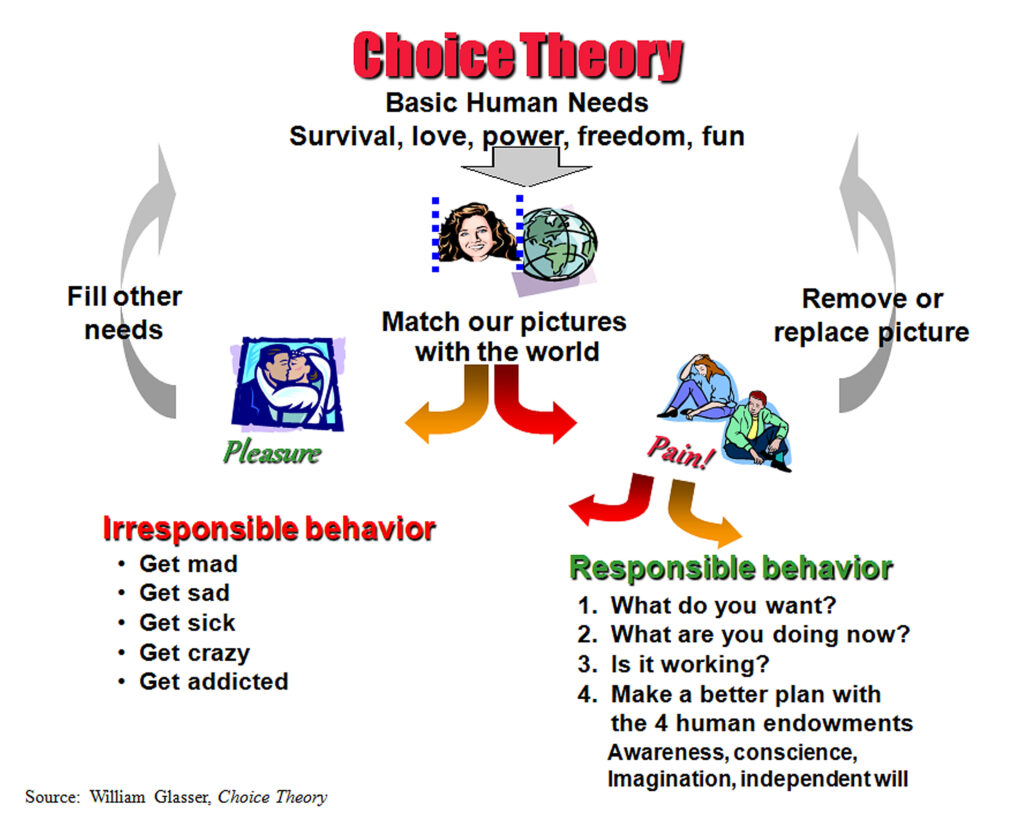What is the best way to move an organization toward a quality culture? How can
positive change be made without eliciting employee anxiety or resentment?
Understanding how people are motivated is key. One thing is certain: people are not motivated by the visions of other people; they are motivated by their own visions. The true leader is able to address the visions of the employee while promoting the mission of the organization. To that end, understanding “Choice Theory” is extremely helpful. The model provides a path by which the leader can direct the natural drives of the employee toward the creation of a quality culture.
Choice Theory: An Introduction
The architect of Choice Theory, the American psychiatrist William Glasser, argued that people are not so different. We all want the basic stuff: belonging and approval, recognition and power, the freedom to make our own choices, and a little fun along the way. All of us are motivated by these basic drives. More importantly, when these human desires are not satisfied, employees start doing weird things. They withdraw, they bog down, they sabotage the goals of the boss or the organization.
Although all of us have the same basic needs—approval, power, freedom, and fun—we carry different pictures in our heads of how those needs are satisfied. Take fun for an example. John’s picture in his head for having fun is sitting at a computer creating a new program. He gets a kick out of inventing a new data base that just might make the job easier for the whole department. John has other pictures which satisfy his need for fun, but creating at the computer is one of the most dominate.
Pete, on the other hand, wouldn’t be caught dead at a computer. He’s an outdoorsman. He pictures himself in the field, checking up on the progress of the job, kicking dirt clods and spiting from the corner of his mouth. That’s fun for Pete, being where the action is.
In order to get the best from each employee, it is essential to understand each personal picture album. Try to stick Pete behind a computer and see what you get. Oh, sure, you might gain surface-level compliance, but in the long run Pete’s performance is going to be half-baked, if that.
Matching the Pictures with The World
People are constantly trying to match the pictures in their heads with the world. As soon as John finishes a new computer program, he is searching for another challenge. He is looking over the shoulders of his co-workers, hoping to find a problem that may be resolved with the benefit of a new program. If John finds such a project, he is happy again. He trudges off to his computer and you may not see him for a couple of weeks. He is content crunching out a new application.
But let’s say John can’t find a new project. In fact, let’s say John is transferred to a new department that doesn’t even have a computer. They’ve got him working an archaic adding machine! You’ve got to be kidding. John’s creativity is squelched. He asks to be given a chance to work on a computer again, but no one is listening. They need someone to work the adding machine and John’s it. His world simply does not match the picture in his head. What to do?
Acting Irresponsibly
When the pictures in your head do not match the world, your needs are frustrated. That’s painful. Now, there is one thing that is certain about human beings: They will not tolerate pain for very long without doing something. Unfortunately, often what they choose to do is irresponsible. Here are some examples:
Acting Out. Acting out is behavior that results in harm to the individual, others, or property. John may choose to harm the integrity of the boss by berating the department at every opportunity. People get used to it after a while. Oh-oh, here comes John. “Can you believe what those chumps are doing now?” John complains. “Management hasn’t got the brains to come in from the rain.”
It may not be long before John is on the street looking for a new job. It’s too bad too; he was a great computer programmer.
Suffering. People with frustrated needs find all kinds of ways to suffer. But the most popular tactic is depression, selected for three basic reasons:
- It works. If John mopes long enough someone may come to his rescue.
- It gives you an excuse to do nothing. John has a fast comeback for anyone who suggests that he “snap out of it” and do something. “How can you expect me to do anything?” he drones. “I’m depressed.”
- Finally, people use depression because it’s socially more acceptable than anger. No one tolerates a grown person who throws a temper tantrum. But having the blues is “normal.”
Addiction. John may decide to deal with his pain by anesthetizing himself with alcohol, drugs, or comfort food.
Addiction is hard to deal with. Ask an addict to give up his drug of choice and watch the reaction. “Hey, man, you must be crazy. You want me to give up pleasure for pain?”
It doesn’t work to tell an addict to just stop. You have to go back to the basic drives. What needs are not being satisfied? How can we satisfy those needs so that the pain subsides?
Other Irresponsible Tactics. There are other ways people deal with pain. Some choose helplessness, some anger, some psychosomatic disorders. Afew become psychotic. The fact is each person is trying—in a crazy way—to cope with the loss of approval, power, freedom, or fun.
A Better Way
There has to be a better way, right? How can you help an employee get back on
track? Or stay on track? Asking these four questions will help immensely.
1. What do you want? It’s a funny question, isn’t ft? Typically, we don’t ask an employee what he or she wants; we tell them what we want. But remember, if you want the best from your employees, you must allow them to do what they do best.
I bet if we talked with John long enough, we would find he wants what we all want: a feeling of acceptance and self-worth. He wants to do what he does best. Why? Because it’s self-satisfying. Management likes the results, and John believes he’s making a meaningful contribution.
2. What are you doing now? If John were honest, he would have to report his current behavior is not like his old self. He’s acting out; he’s depressing; he’s addicting.
3. Is it helping? The answer is no. All of John’s irresponsible behavior is not helping him to get what he wants. In fact, his behavior is so poor his chances for a positive change in the company are getting dimmer with every day.
4. Can you make a better plan? It all comes down to this: problem-solving. Simply asking, “How can John and the company get what they both need?” Basically, that question can be answered by exploring three resources: old behavior, new information, and creative ideas.
What old behavior has worked in the past? “You like to work on computers? I didn’t know that. Maybe we can work something out.”
What if it is not that simple? What if all of John’s past behavior doesn’t seem to fit the current job requirements? At that point it’s time to look for new information. A good place to start is with John’s supervisor. It could be that John’s boss knows something that John does not know, a new project coming on line for example. Perhaps John’s needs could be satisfied by working on that new project. It’s worth exploring.
When all else fails, it’s helpful to let the mind produce creative ideas. That’s something the brain does naturally. Unfortunately, the brain does not distinguish between what is moral and what is immoral; it simply punches out one idea after another.
But together John and his boss may devise a plan that was previously hidden from both of them. Such discovery can be exciting, and it grows out of asking a fun, two-word question, “What if? What if we tried this? Would that work?”
Summary
William Glasser’s concepts have been hammered out in psychotherapy, education, and industry. They work because they are basic and true to life. Choice Theory is a problem-solving method of dealing with poor performance. It doesn’t waste time with past history; instead, it focuses on a plan for now. What can we do now to help you get what you want? And how can we make that match what the company needs? It is that simple—and that profound.


